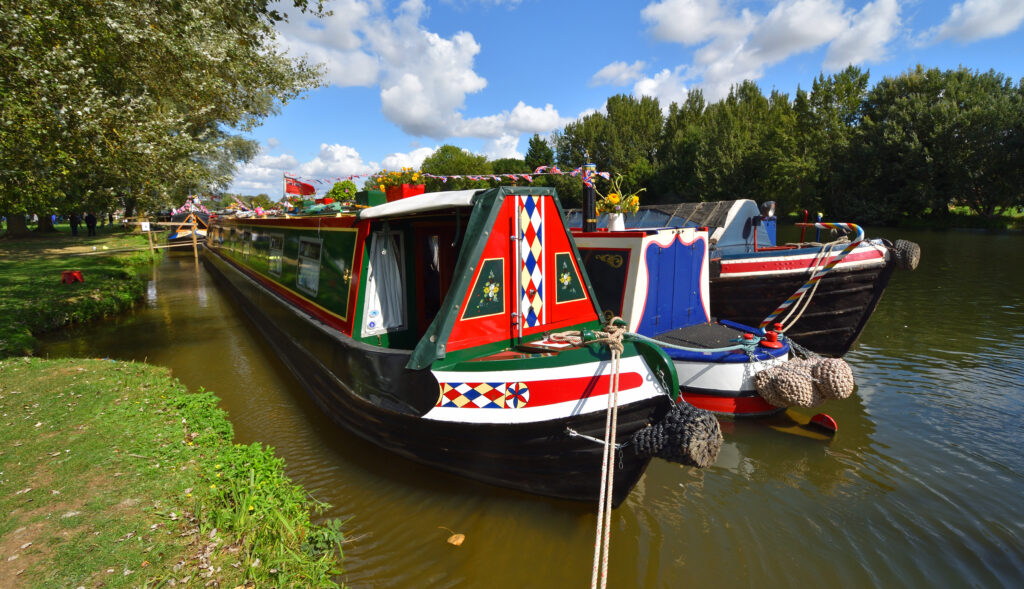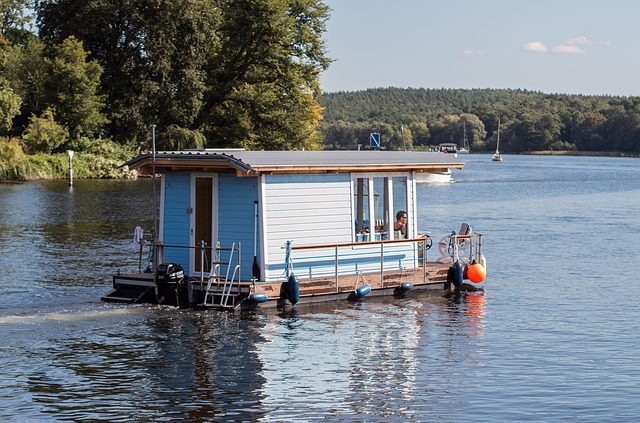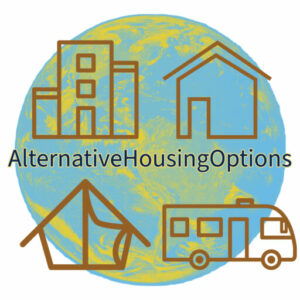Boating is an activity I associate with nice weather, time with friends and family, relaxing, and fishing. Since we are not a big boating family and don’t own one ourselves, I’ve often thought it would be interesting to live on a houseboat. Of course, in my mind floats the image of the yacht with multiple cabins and decks, which is super unrealistic for me, but in exploring alternative housing options, I have found there are many types of boats–large and small that you have as a liveaboard.
A floating house is a permanent home on the water built on a floating platform that is not meant for traveling. Houseboats encompass a broad category of boats you can live aboard and either travel with or have moored at a dock. We’ll explore the pros and cons, costs, and mooring involved with these alternative housing ideas so you can determine which is right for you.
What is a houseboat?

A houseboat is a boat that has been built or adapted to be used primarily as a home. Generally speaking, houseboats are large vessels built with most of their emphasis on amenities, comfort, and living space and less on their efficiency as a boat. Some houseboats are not motorized because they are usually moored, kept stationary at a fixed point, and frequently tethered to land to provide utilities.
People use the term “houseboat” loosely to describe mobile vessels and floating homes. Like barges, trawlers, yachts, and boats, houseboats are free to roam and dock where permitted.
What are the advantages of living on a houseboat?
Lower cost of living– living aboard will often be far cheaper than renting or owning a traditional home. In a traditional home, you have utilities costs for gas, electricity, and water. But you’ll also have property taxes, homeowners insurance, and possibly HOA fees. When you live aboard a houseboat, you will have fuel costs, freshwater (unless you have a system to purify lake or river water), boat insurance, septic pumped out at a marina, and yearly registration.
Unlimited fishing– you can fish any time you wish on your houseboat, especially if you’re retired. You may have to limit your fishing if you have a job. With the sea as your garden, you have unlimited fishing year-round.
Maintenance– there is less to repair on a houseboat than on a traditional home. You will have repairs now and then, but you have less that can break overall.
Smaller area to clean– your cleaning can be done much faster and easier than in a traditional home. You will have typical chores such as laundry, dishes, and general upkeep. You won’t have to vacuum, dust, or wash windows as frequently.
Community– You’ll often find a group of people that you regularly dock, allowing you to make friends easily no matter where you dock. It’s not hard to find like-minded people who love boating.
What are the disadvantages of living on a houseboat?

Size– a houseboat is typically small, like a tiny house at 500-600 square feet. Downsizing can be a shock.
Storage– you’ll need to store items separately in off-site storage for the off-season or if you have items, you couldn’t part with and need them kept safe. This is an extra cost. For on the boat consider these foldable storage containers, when not in use you can slide them under the bed or any flat area.
Transportation– most houseboat owners, don’t have a car. If traveling on land, you will need to pay for another form of transportation like bikes, taxis, or Uber.
Weather– hurricanes, floods, and heavy storms can cause you to change your plans when living on a houseboat. Extreme weather will cause you to have a backup plan for staying inland and storing your boat in a secure location. If an area is impassable, you’ll need to go somewhere else or wait until water levels are favorable.
Climate– it is less than ideal living on a houseboat in freezing temperatures. You can plan for storage, extra weatherproofing, or alternative locations to avoid cold temperatures.
Lack of hosting space– houseboats are not generally known for large dining rooms, and often the deck space is minimal. You probably won’t be hosting large parties or holiday gatherings. It can also be difficult for a family to live on a houseboat the size of a tiny house.
Groceries– houseboats don’t allow for large pantries and frozen food storage. You’ll need to get used to eating fish. Depending on how often you dock, you may be visiting a grocer when you are docked at the marina for items you need for the next week or month.
How much does it cost to buy and live on a houseboat?
The cost to buy a houseboat will vary depending on the age, type, and length. To put it in perspective, a new houseboat has more upfront costs, but the recurring costs are often much less than a traditional home. A late-model, used houseboat, like a Stardust, Somerset, or Sharpe, with an Aluminum Hull that costs $125,000 – $250,000 and will be roughly $1800/year to insure. If you’re financing your houseboat, you’ll likely need an out-of-water survey done which can run approximately $14.50/foot (overall length of the boat).
Depending on where you moor your houseboat, you may have slip payments plus utilities. Slip rental can range from $300 – $2,000/month plus utilities. According to YourNewBoat.com, here are some good averages to consider:
Example Monthly Houseboat Budget:
- Boat Payment $$$ (this depends)
- Insurance $120 – $180
- Slip Rental $300-$2,000
- Electric $60 – $120
- Pumping $45
Purchasing a houseboat is not the same as purchasing a home. They are much like automobiles in that their value is supposed to depreciate over time. On the other hand, floating homes will appreciate at rates comparable to (or even faster than) conventional homes in some areas. Depreciation is typically 20% in the first year and 5-10% each year.
You can find areas to moor for cheap, but marinas and mooring areas often change their rules; it’s best to call ahead when making travel plans. allabouthouseboats.com has a marina directory.
What are the best areas to moor a houseboat?

There are many areas with beautiful weather and water that you could consider for mooring your liveaboard. Here are a few examples.
- Miami, Florida
- Lake Havasu, Arizona;
- Sausalito, California;
- Fort Washington, Maryland;
- Seattle, Washington;
- Portland, Oregon;
- Hot Springs, Arkansas;
- Shasta Lake, California;
- Lake Cumberland, Kentucky; and
- Fort Worth, Texas.
What is a floating home?

If a vessel doesn’t have an engine and drive system, it’s generally considered a floating house and not a houseboat. Homes that are permanently docked on the water are called floating homes. They are berthed indefinitely and connected to city water and sewer.
What are the advantages of living in a floating house?
No motor– unlike houseboats, they don’t need a motor. They don’t move. You can build upwards or outwards without affecting the cruising ability since all it needs to do is float. You save gasoline because you’re not traveling.
Community– living in a floating home community can be an enjoyable experience. Neighbors tend to know each other better, being nearby, but there’s also a general feeling that they need to take care of each other and their neighbors’ property when not in residence.
Nature-on a floating house, you have access to nature any time of the day; you can enjoy the sunrise or sunset over the water, watch local wildlife from your deck and go swimming or participate in water sports.
Tax-cut– a floating home does not technically constitute owning “real property,” and there may be no property taxes associated. Some states instead consider a floating home “personal property” and require a minimal annual personal property tax to be paid.
Solitude– Floating houses can be found in rural or less populated areas. They are a great escape from the noise of cities, but you still have friends or family that live nearby to visit during the weekend.
Green building– builders of floating houses often have green building expertise that can be used to make the home as energy-efficient as possible. Features like solar panels can help save energy like heating water for a warm shower. Lakeview homes have proven to increase in value over the last decade.
Larger in size– floating homes are typically about 1200 square feet, the size of a small house- quite a bit larger than a houseboat or tiny home. This also allows you to have a few more belongings and food storage or items.
What are the disadvantages of living in a floating house?

Waterfront costs- buying a floating house may initially cost more due to living on the water. It may also be challenging to find dock space to build a non-mobile floating house.
Higher monthly bills– floating homes can have a higher monthly bill due to mooring fees and monthly electricity, water, sewage, and other utilities similar to an RV at an RV park.
Weather and illness– potential owners should consider seasickness, motion sickness, weather, wind, and other extreme climates, which can damage homes (and homeowners) that are not prepared.
Family and pet safety– if your floating home is a family home, you’ll need to be sure your children and pets can all swim. The water surrounding your floating home may also need to be tested regularly for E. coli.
Downsize– floating homes can be larger than tiny homes and houseboats, but they are not often 2000 square feet without a hefty price tag. You may need to downsize or pay for extra storage of your items to live in a floating home.
Transportation– many floating home residents do not have a vehicle. You may need to pay for transportation like a taxi on grocery day or if you work outside the home.
Financing– When buying a floating home, consider that approximately 30% of the floating homes listed for sale are CASH ONLY purchases. If the home is listed under $150,000, it likely does not qualify for a home loan. There are only two floating home lenders. You cannot purchase a floating home with an FHA or VA loan. The lenders require at least a 20% down payment and higher interest rates than traditional homes.
How much does it cost to buy and live in a floating house?
You can buy a floating home for $35,000–$1 million. You will also need to rent or purchase a slip, and you will pay an extra fee for mooring tenancy. These are similar to HOA fees and run between $300–$800 a month. Building a floating home can be challenging. A 1,200 square foot floating house can be built by the average person in about one month, starting at about $120,000.
Floating houses may have a tax advantage over traditional homes. Tax rules vary across the US, so it may take some research to find your lake, county, and state guidelines. Ask your tax advisor for advice.
Based on our findings for alternative housing ideas for boaters, which is your favorite? Comment below.
If you’re interested in more permanent or unique forms of alternative housing, check out our 25 alternative housing ideas articles to get your imagination floating.


